Yellowstone has mesmerized visitors for years as America’s oldest and perhaps most unique National Park.
If you plan a trip to Yellowstone National Park, covering over 3,500 square miles in just three days can be overwhelming.
Don’t worry, though; we have you covered in this post.
With some planning and our 3-day Yellowstone Itinerary, you will be ready to hit the road quickly!
Now, I don’t want to mislead you.
You won’t be able to see everything with only a 3-day itinerary, but you will definitely get to see the major sites.
During our three days in Yellowstone, we could enjoy a little hiking and many awesome geological features.
I’m talking about cool geysers, awesome hot springs, and several waterfalls, and I even took in some scenic drives.
We even returned to the lodge during the busiest part of the day to escape some of the crowds!
Exploring Yellowstone in 3 days was the perfect time for us as we were coming off two months of travel!
During these two months, we visited Chicago, San Francisco, Ruidoso, White Sands National Park, Roswell, Carlsbad Caverns, and Yellowstone!
Needless to say, we were a little tired!
Of course, we have learned how to save money to accomplish this great journey!
This ensures our travels never end!
Enough about us; let’s get busy and plan your Yellowstone trip!
*This post contains affiliate links. By purchasing through these links, we get a small commission at no additional cost. That Texas Couple also participates in the Amazon Services LLC Associates Program. As Amazon Associates, we earn from qualifying purchases.
Let’s Connect on Social Media!
About This 3-Day Yellowstone Itinerary

Our 3-day Yellowstone trip is designed for the summer months (mid-May through October).
This is when all the roads in Yellowstone National Park are open, allowing visitors to easily navigate to all the major sites.
While you can visit Yellowstone in the winter, several roads are closed during this season.
This makes navigating the park becomes much more difficult.
I know that the summer months are the peak months in Yellowstone, but to see all the major sites on our 3-day itinerary for Yellowstone, we must put up with the larger crowds.
Yellowstone is one of the top 5 most visited National Parks in the United States.
According to the National Parks website, it attracted almost 4 million visitors in 2020.
Don’t worry; we will give you tips on this itinerary to help you navigate the crowds during your summer trip to Yellowstone.
When to Visit Yellowstone

I CRINGE A LITTLE whenever I write about the best time to visit someplace.
For some places, like Glacier Bay National Park, it’s an easy question to answer.
This is honestly so subjective.
It so often depends on the preferences of the person.
We wrote a detailed post on the best time to visit Yellowstone National Park to help you make the best decision for your trip.
This post outlines the pros and cons of all seasons and offers tips for activities depending on the time of year.
Note that the peak season is the summer months of July and August.
That means they are the most crowded and the most expensive.
Many people also go on road trips to this area with their campers during the summer.
We saw a lot of them with license plates from everywhere!
Random note: The picture above was the gorgeous sunsets we captured in Yellowstone. It inspired me to write a post containing great sunshine captions that I could pair with these pics!
How to Get to Yellowstone National Park
If you read this three-day Yellowstone itinerary, you probably don’t live close enough to Yellowstone National Park to drive there.
That said, you are either going on a road trip to Yellowstone or flying into an airport near Yellowstone and renting a car.
No matter what, you need a car to explore this 3-day itinerary.
Nearby Airports
We have summarized each of the nearby airports below. In this post, we will discuss the airports near Yellowstone in more detail.
Yellowstone Airport (WYS) is the closest airport to Yellowstone. Located just 3 miles from the west entrance, flying into this airport will make visiting Yellowstone easy to drive.
However, flights to this small airport can be expensive. In addition, rental cars are often hard to come by, so this might not be a viable option for your trip.
Yellowstone Regional Airport (COD) is located near the east entrance in Cody, Wyoming, and is the second closest airport to Yellowstone.
As this is another small airport, flights here are limited and expensive.
Bozeman Airport (BZN) is located in Bozeman, Montana, and is relatively close to both the north and west entrances.
The drive to each entry point is just over 1.5 hours.
Jackson Hole (JAC) is another of the airports near Yellowstone. Located in Wyoming, Jackson Hole Airport is approximately a 1-hour drive from the south entrance of Yellowstone.
Many people stay in Jackson Hole and make it their home base for exploring Yellowstone.
You will definitely find cheaper accommodations here.
Staying in Jackson Hole will allow you to easily add Grand Teton National Park to your Yellowstone trip.
Note that you must plan extra drive time on your itinerary if you will be staying in Jackson Hole.
Billings Airport (BIL) is in Billings, Montana, about 1.5 hours from the North entrance (well, the northeast entrance) to the park.
Salt Lake City Airport (SLC) is much farther from Yellowstone National Park than the other airports on our list, but it is a convenient major airport you might consider using.
We flew into and out of Salt Lake City to visit Yellowstone.
SLC was the cheapest from Dallas and the only place we could find a rental car!
If Salt Lake City is your choice, be prepared for a road trip.
It is a 4-hour and 45-minute drive to the west entrance or a 6-hour and 15-minute drive to the south entrance.
Many people plan on an even longer road trip to the South entrance.
This is so that they can include Grand Teton National Park on their Yellowstone itinerary.
While I wish we could have visited Grand Teton National Park during our visit, we could only manage a Yellowstone 3-day itinerary.
Because of that, we opted for the West Yellowstone entrance to save time.
Where to Stay in Yellowstone National Park

We definitely recommend staying inside the park if at all possible. This will greatly reduce your drive time.
If you stay three days or longer, I recommend planning your trip with several different lodging options. (We give suggestions below.)
Again, Yellowstone National Park is a huge park, and the attractions are spread out.
Being strategic about where to stay will help you save valuable time on your trip to Yellowstone.
We booked our trip last minute (literally the day before we left) and were lucky to find they had cancellations inside the park!
We stayed in Canyon Village during our time in Yellowstone. Canyon Village has newly built lodges with nice rooms and full bathrooms.
We mainly chose to stay at Canyon Village because of its central location inside Yellowstone.
Check out all of the cabin rentals near Yellowstone National Park as well. This is a great option, for sure!
We know that many people stay in West Yellowstone just outside of the west entrance when visiting Yellowstone.
We did drive through West Yellowstone and stopped for gas on our way to the west entrance on day 1.
The town of West Yellowstone was super cute.
West Yellowstone offers many different accommodation options, several restaurant choices, and shopping.
Honestly, West Yellowstone looked like a fun little mountain town.
It sits at the west entrance, similar to Estes Park sitting at the entrance to Rocky Mountain National Park.
Remember that you will have extra driving time entering and exiting the park each day if you stay in West Yellowstone.
How Many Days Do You Need in Yellowstone National Park?
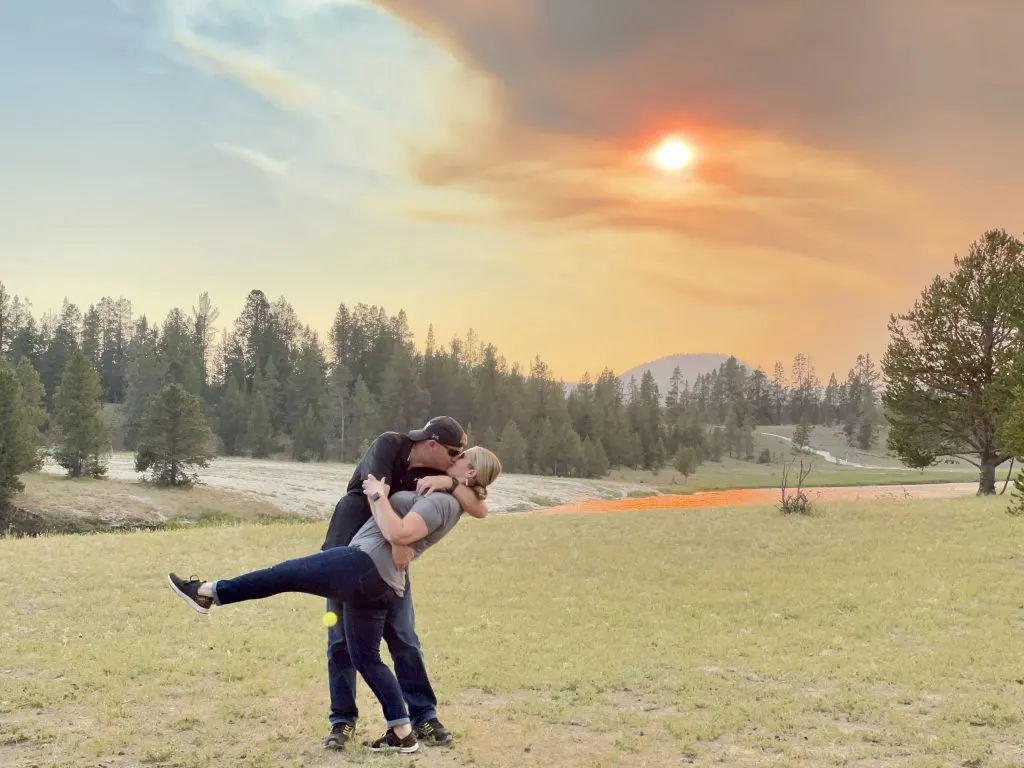
You really need a minimum of three full days in Yellowstone.
A Yellowstone 3-day itinerary will allow you enough time to see all the major attractions, but you will be on the go a lot with this itinerary.
You can scale down the itinerary to meet your needs if the pace is too much.
With that in mind, if you can do 4 days in Yellowstone National Park or longer, that would be even better.
Four days or longer would allow you to see the top sites of Yellowstone at a slower pace.
You can add more hiking and leisure time to your Yellowstone itinerary.
Tips For Planning Your Trip To Yellowstone National Park
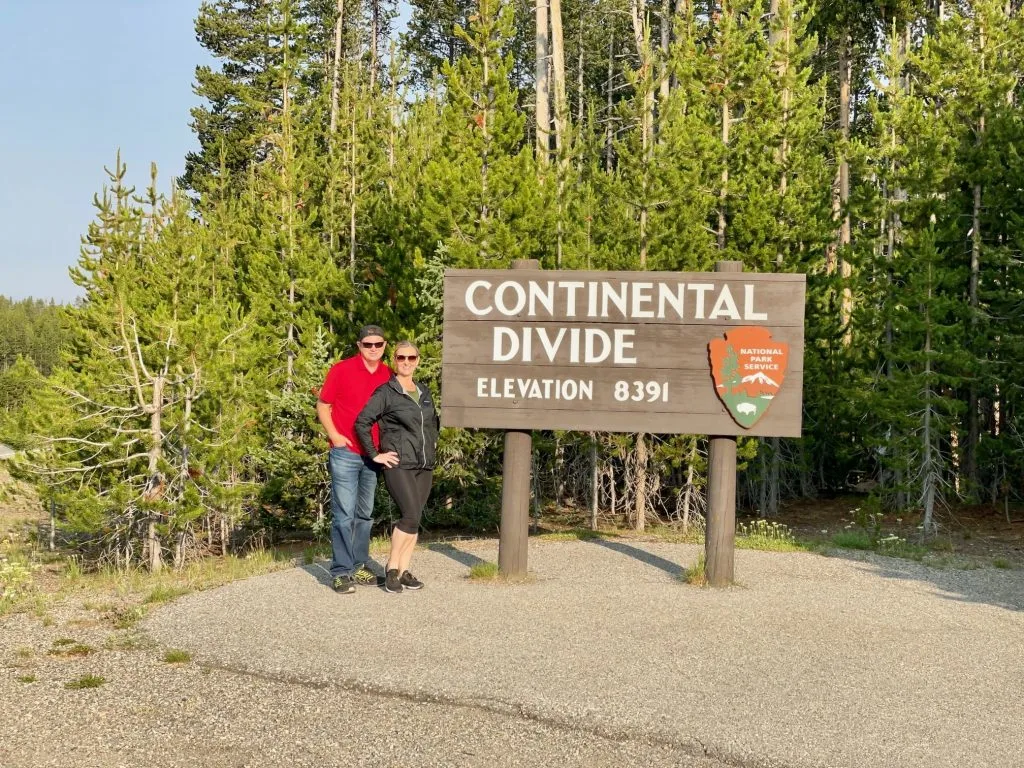
Book in advance
The lodging options inside Yellowstone fill up months in advance.
Book in advance to ensure you get your first choice(s) and the best price.
As I said, we got lucky when we booked our last-minute trip, as there were cancellations at Canyon Village. I wouldn’t advise counting on this.
Don’t risk it. Some lodging options fill up as far as nine months in advance!
Entrance Fee
At the time of publication, the entrance fee to Yellowstone was $35 per vehicle. This is good for seven days.
If you visit several National Parks, consider buying an annual park pass instead.
The annual pass is $80 and allows you entry into all of the National Parks in the United States.
You can purchase both options at the park entrance ticket booths.
Plan for Limited Cell and Wi-Fi Service
There is limited or no cell service within Yellowstone.
The only place we had cell service was Mammoth Village.
Our lodge at Canyon Village offered wifi, but it was only accessible in the lobby of the main lodge.
We chose not to purchase the wifi since we stayed in a different lodge in Canyon Village.
Because of this, download offline maps and/or have paper maps available to use.
Plan Extra Time For Travel
Once inside Yellowstone National Park, be sure to allow extra travel time. You will find that the attractions are spread out far away from one another.
Also, it is not uncommon for you to be caught in a traffic jam in the park.
These traffic jams are often caused by wildlife in the roadway, especially bison.
Other times, people cause traffic jams when they stop in the middle of the road to take photos.
Don’t do this! If there is something you want to take a picture of, pull over into one of the many pull-offs.
Interacting With Wildlife
One of the highlights of visiting Yellowstone National Park is seeing so much incredible wildlife.
Just remember that these are wild animals.
You should always obey the rules and laws of interacting with wild animals.
Always keep your distance and never approach a wild animal.

3 Days in Yellowstone
Day 1: Geysers and Hot Springs
Morning: Old Faithful Geyser and Upper Geyser Basin: Grand Geyser, Castle Geyser, Daisy Geyser, Morning Glory Pool
Midday: Biscuit Basin, Midway Geyser Basin: Grand Prismatic Spring, and Grand Prismatic Overlook from Fairy Falls Trail
Afternoon: Firehole Lake Scenic Drive (stop at Gibbons Falls), Norris Geyser Basin
Stay in: Canyon Village, West Yellowstone, or Old Faithful Inn
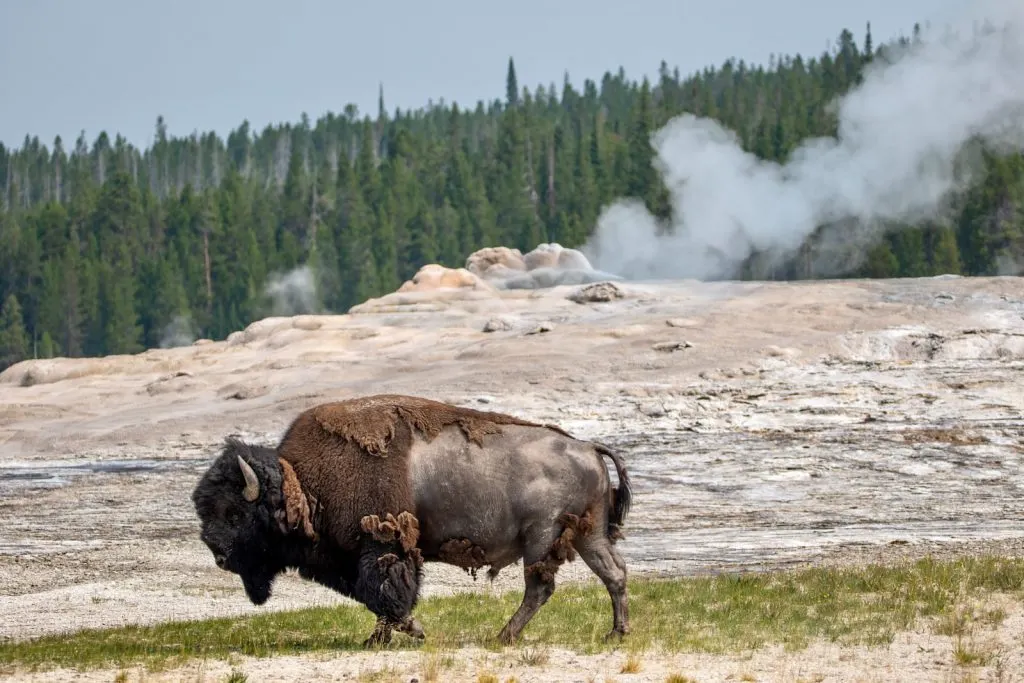
Yellowstone National Park is home to the world’s largest concentration of hydrothermal features (over 10,000), making this one amazing park.
Seeing these hydrothermal features is the best way to start your trip to Yellowstone.
Might as well jump right in with the unique features in the park, the geysers, and the colorful pools.
Now, on our route today, we will start out by heading south and then work our way back to the north. This route works well from the west or south entrance.
Since all of the major attractions in Yellowstone are on the Grand Loop Road, it is easy to reverse the route if that order better suits your direction of travel.
Pro Tip:
Be sure to download offline maps to help you plan your trip and stick to your itinerary!
You can also download the Yellowstone National Park app to learn more about the park and the sights you will see.
Old Faithful Village and Geyser
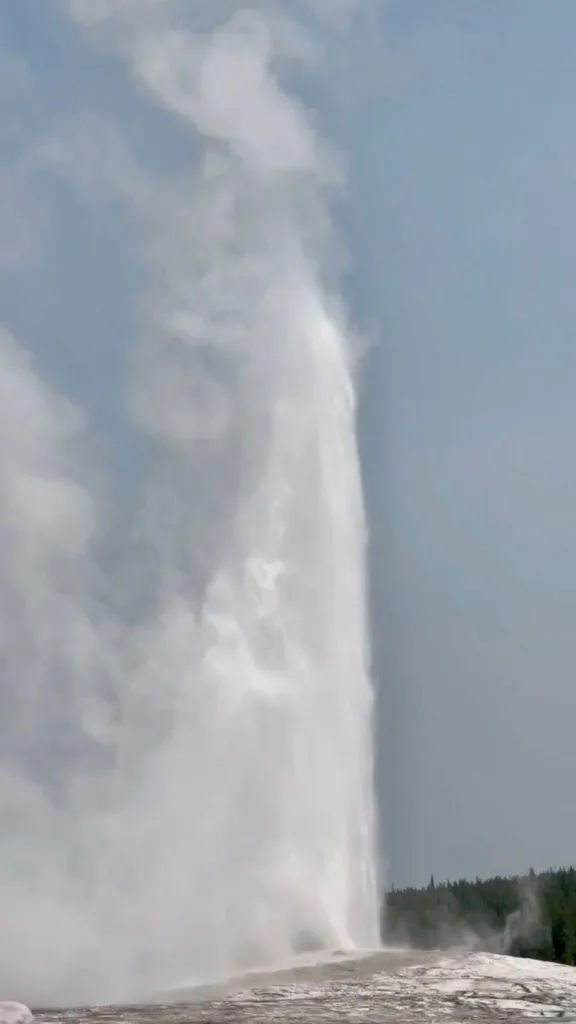
Begin your day bright and early and head to the iconic Yellowstone Park Old Faithful Geyser before the crowds.
I feel like the Old Faithful Geyser doesn’t really need any introduction.
People have been flocking to this geyser for years.
Old Faithful “faithfully” erupts about 20 times a day at intervals between 60 and 110 minutes.
The eruption from the Old Faithful Geyser can last anywhere from 1.5 to 5 minutes. Once it starts, it averages about 130-140 feet in height.
Since cell service is limited, you can try to time your visit to the Old Faithful Geyser just right or ask a park ranger for estimated eruption times.
If you have wifi and have downloaded the Yellowstone National Park App, you can also check the Old Faithful eruption time there.
Plan to arrive at the Old Faithful Geyser 15-20 minutes early.
This will give you time to park and walk to Old Faithful.
If possible, park down by the drive-up entrance to Old Faithful Inn.
Take the first left turn after exiting the main park road.
A parking lot exists between Old Faithful Inn and Old Faithful Basin Grill Store (follow Old Faithful Inn Road).
This lot isn’t as well known, so it is an easy entry and exit point to explore the Old Faithful area.
After parking, head immediately to Old Faithful. I would hate for you to miss Old Faithful erupting because you became interested in another attraction.
Of course, you can explore the area if there is a lot of time before the next eruption.
The Old Faithful Visitor Center, the historic Old Faithful Inn, gift shops, and restaurants are all in the village.
The Old Faithful Inn is a great place to grab a drink and watch Old Faithful erupt from the balcony.
We were lucky and timed our visit just right, only waiting about 5 minutes.
Old Faithful definitely puts on a show and is a great introduction to the amazing features of Yellowstone National Park.
I must admit, it made me giggle when people clapped at the end. Who were they clapping for? Mother Nature, maybe?
I don’t know, but it made me smile regardless!
Upper Geyser Basin: Grand Geyser, Castle Geyser
Don’t plan your Yellowstone itinerary to see Old Faithful and then leave.
If you do, you will miss out on some incredible hydrothermal features of the park.
And, honestly, one of the geysers we thought was way better than Old Faithful!
The Upper Geyser Basin is home to some of Yellowstone’s most predictable geysers and incredible hot springs.
Grand Geyser and Castle Geyser

If you make it to Old Faithful and have time to kill, check the schedule for the other geysers in this area, including the Grand Geyser, which erupts approximately every six hours, and our personal favorite geyser, Castle Geyser.
Again, we timed this walk perfectly.
As soon as we approached Castle Geyser, it started erupting.
Castle Geyser was amazing.
The large cone pushed water almost 90 feet high as it trickled down the side of the cone, looking like a beautiful fountain.
It is incredible!
The water eruption lasts about 20 minutes, followed by noisy steam for about 30 minutes.
Morning Glory Pool
The Upper Geyser Basin is home to many other geysers and several springs.
One of the hot springs that has to be on your itinerary is the Morning Glory Pool.
The Morning Glory Pool reminded me of a smaller version of the Grand Prismatic Spring.
The colors were beautiful.
Be sure to follow all the safety protocols when visiting the hydrothermal areas.
Stay on the pathways, and don’t ever throw objects into the geysers, hot springs, or even rocks.
Biscuit Basin
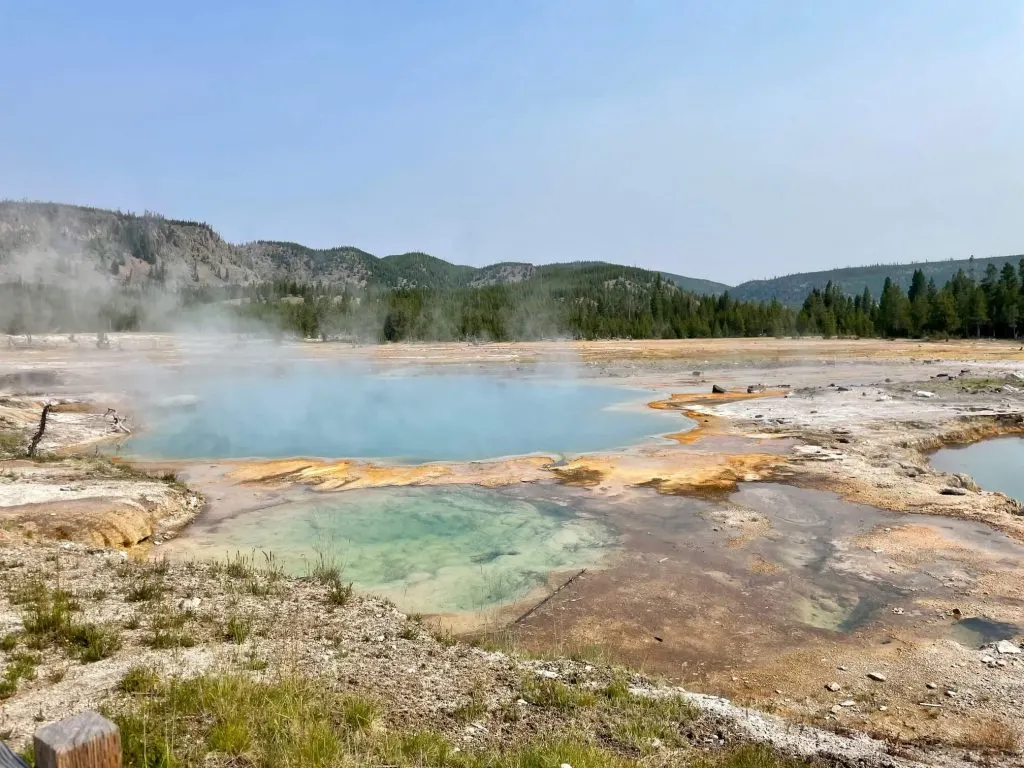
After leaving Old Faithful and the Upper Geyser Basin, our next stop is Biscuit Basin.
Biscuit Basin is a great addition to your Yellowstone itinerary. This easy-to-walk boardwalk area includes several thermal features like small geysers and pools.
The Jewel Geyser is found here and is easy to see as it erupts every five to ten minutes with water shooting anywhere from 10- to 30 feet.
Another popular feature here is the Sapphire Pool.
This pool has a gorgeous blue color and, up until 1968, was known for violent eruptions.
Today, it is a gorgeous blue-hued pool that remains relatively quiet.
Midway Geyser Basin: Grand Prismatic Spring
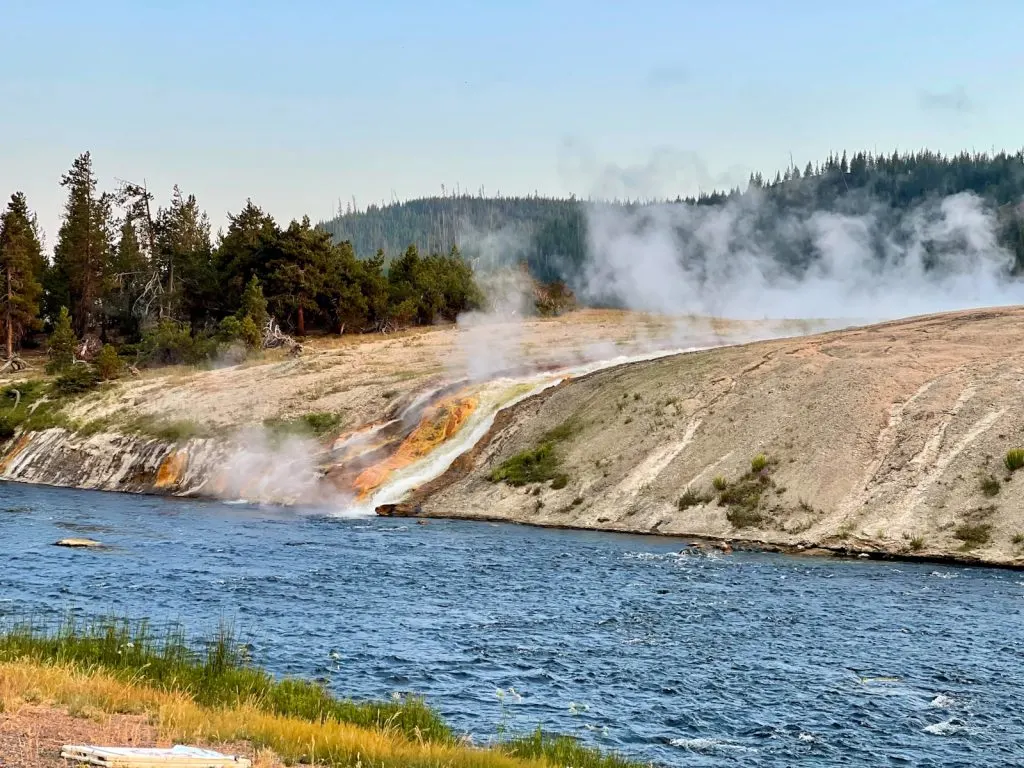
Next on your itinerary is to make your way to Midway Geyser Basin: Grand Prismatic Spring.
The Midway Geyser Basin is a relatively small geothermal area, but don’t skip it, as it has one of the best hot springs in Yellowstone, the Grand Prismatic Spring.
After parking by the gorgeous Firehole River, follow the boardwalk around the other geothermal features at Midway Geyser Basin, like the gorgeous blue Turquoise Pool and the colorful Opal Pool.
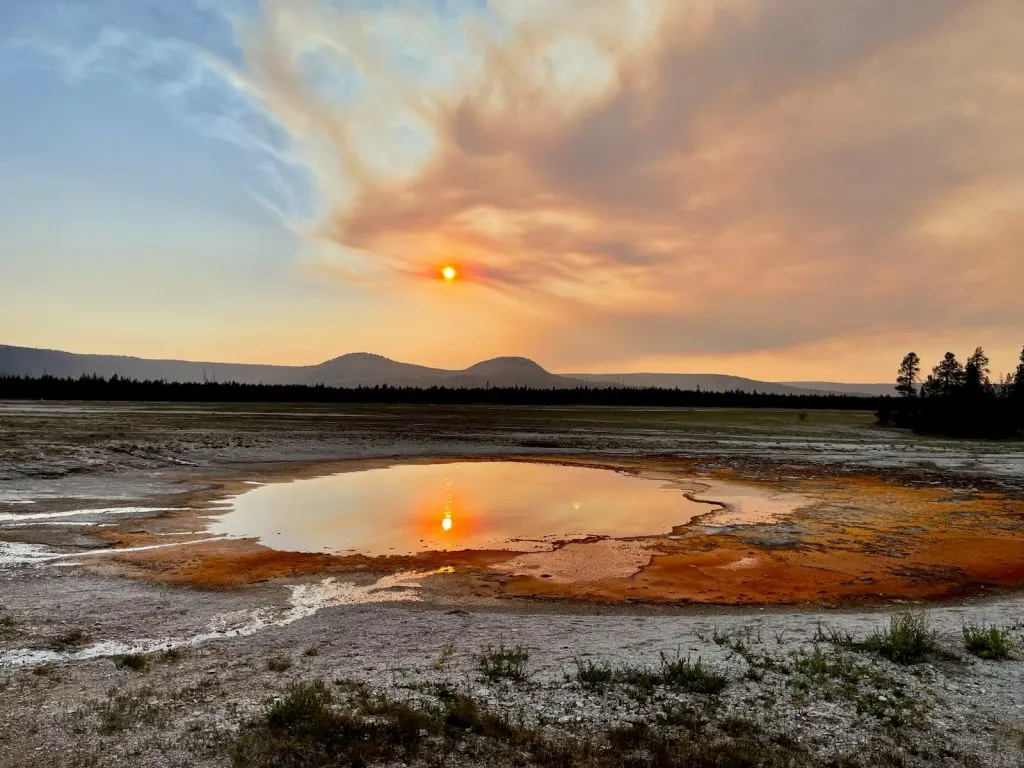
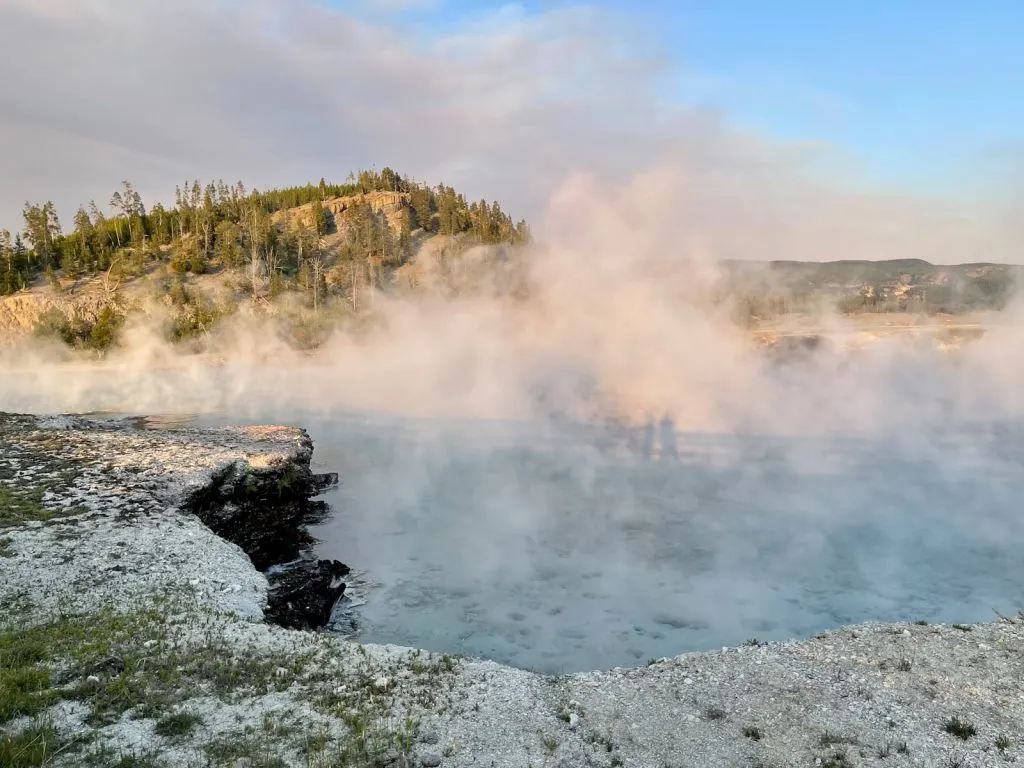
While those are great, they are not why we are here.
We are here to see the largest hot spring in the United States and the third-largest in the World, the Grand Prismatic Spring.
Known for its incredible colors caused by the microbial mats around the edge of the water, this attraction is truly breathtaking.


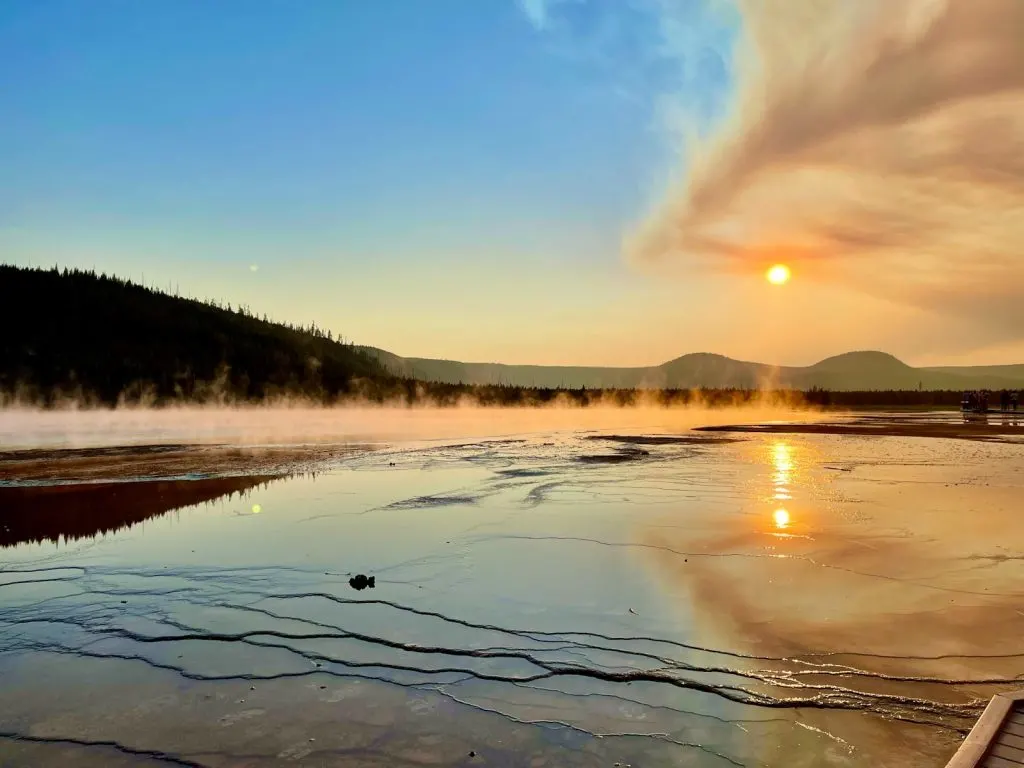

Grand Prismatic Spring Overlook
While the Grand Prismatic Spring looks great from the ground, it looks even better from above.
So, the next stop on your 3-day itinerary is the Grand Prismatic Spring Overlook.
You can access the trail from the Fairy Falls Trailhead.
After parking, follow the path over the Firehole River and walk on the gravel trail until you arrive at the first split in the trail.
Here, take a left and start heading up the hill until you arrive at the Grand Prismatic Spring viewing platform.
There really is nothing better than seeing the Grand Prismatic Spring from above.
The view of the hot spring and the basin are breathtaking.
Unfortunately for us, the steam from Grand Prismatic was intense during our visit, so we did not get to see the full extent of the gorgeous colors.
Regardless, the view was spectacular and well worth the time on our itinerary.

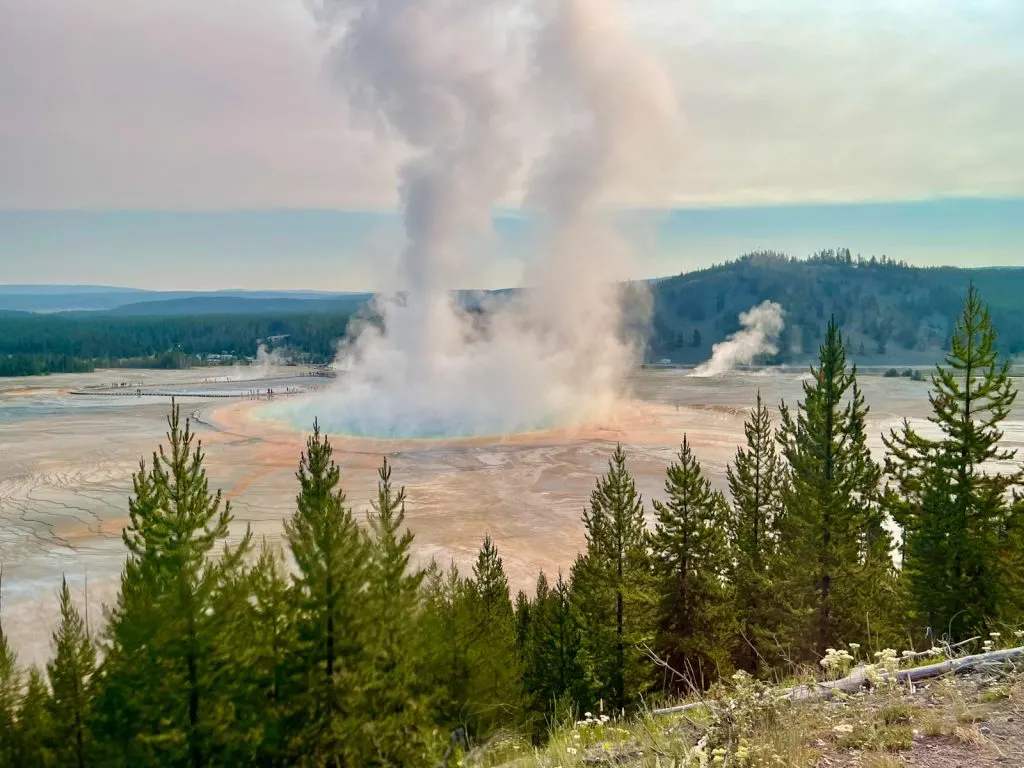


Fairy Falls
If you have extra time or want to skip something else on the itinerary, you can continue your hike to Fairy Falls.
The round-trip hike from the parking lot to Fairy Falls is 5 miles.
After you leave the Grand Prismatic Spring Overlook area, continue the hike until you reach Fairy Falls and are rewarded with the view of the 197-foot waterfall.
Fountain Paint Pots (optional)
The Fountain Paint Pot Trail is in this area also.
You are in the right place if you want to see the pools that look like boiling mud.
This .5-mile loop trail will take you past several fountain paint pots. They are named this because when the mud bubbles, it looks like a pot of bubbling paint.
This area also has several pretty pools (as seen below).



Firehole Lake Loop Scenic Drive
The 3-mile Firehole Lake Loop might seem like something you can skip, but trust me when I tell you that this short loop is well worth your time.
There are several geysers along this short stretch of road. The Great Fountain Geyser is one of the first you will see, and you are very lucky if you are here when it erupts.
The Great Fountain Geyser is unpredictable as it can erupt as little as 2 hours apart or as many as 13 hours!
Once it does start erupting, it continues for about 45 minutes, so that’s a positive at least.
Firehole Lake Loop also has the White Dome Geyser and a great boardwalk area around Firehole Lake.
Two streams flow through this area of the basin. We visited at sunset and were able to catch some gorgeous photos.

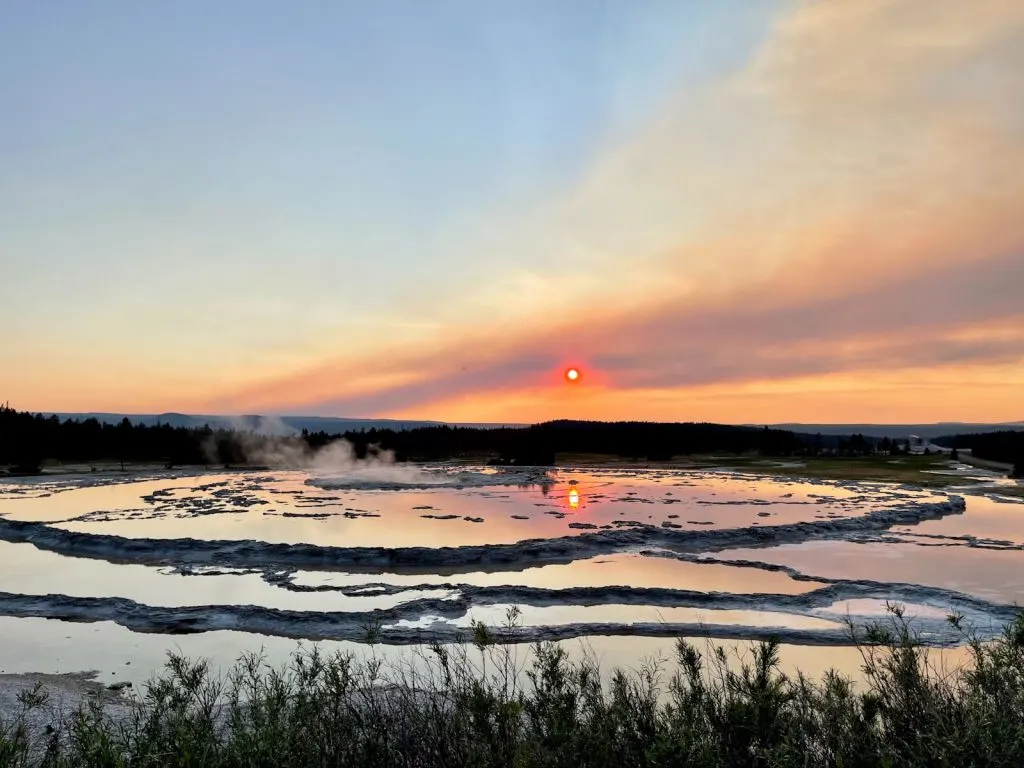


Gibbon Falls
Continue along the Grand Loop Road through Yellowstone Nation Park to reach the next attraction on your itinerary, Gibbon Falls.
Be careful when entering. This area can get very busy during peak hours, so proceed cautiously into the parking lot.
After parking, follow the pathway all the way down to the bottom viewpoint for the best views of Gibbon Falls.

Norris Geyser Basin
Itinerary day 1’s final stop is at the incredible Norris Geyser Basin, one of the fastest-changing geyser basins in Yellowstone.
North Geyser Basin comprises two different basins: Porcelain Basin and Back Basin.
Porcelain Basin
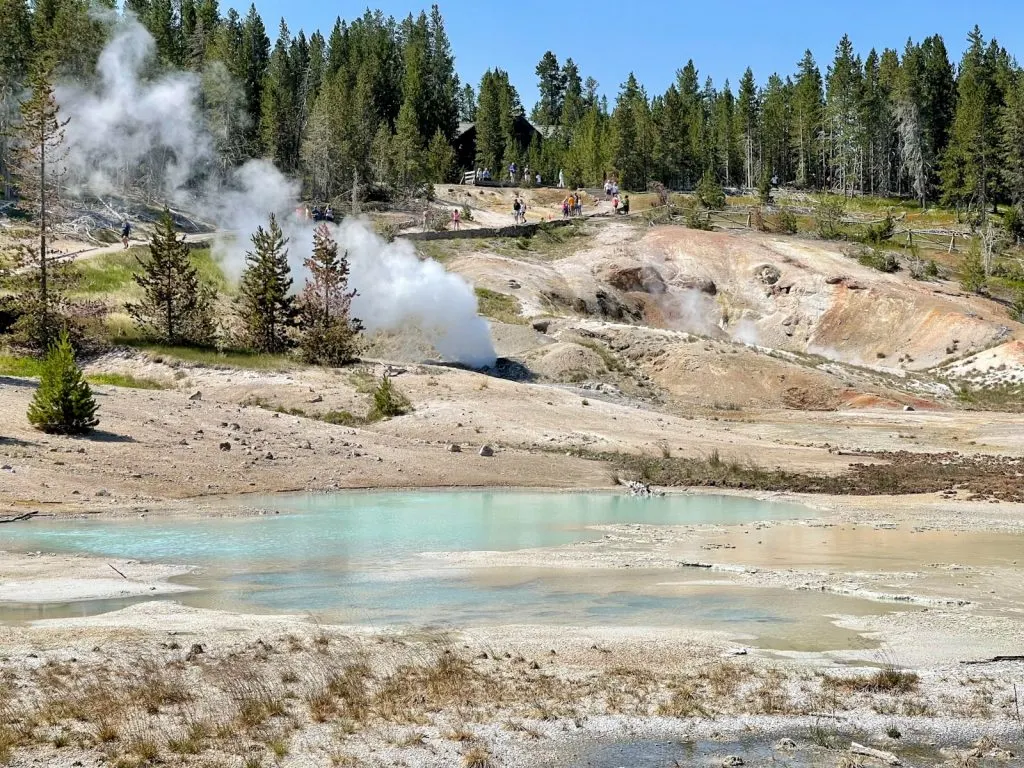
When you plan your Yellowstone itinerary, decide if you want to see both of the basins at Norris Geyser Basin or just one.
Our main reason for stopping at Norris Geyser Basin was to see Porcelain Basin, but we also explored a little bit of Back Basin.
The Norris Geyser Basin makes you feel as though you are up close and personal with the changing landscape of Yellowstone.
As you walk the boardwalks of Norris Geyser Basin and look around, you can see the “life” of the basin surrounding you.
The North Geyser Basin envelopes you in thermal features, sparking your senses immediately.
You can see the steam coming from the vents and hear the water bubbling while you see and smell the erupting geysers.
Norris Geyser Basin is really an incredible place.


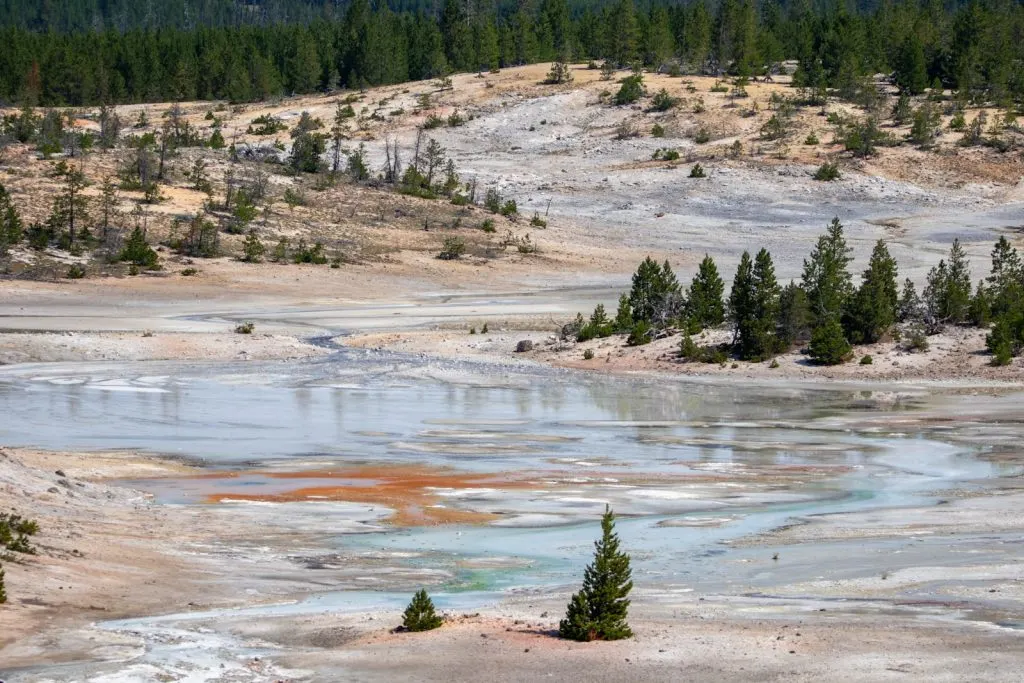

Back Basin
The Back Basin area is best known for the world’s largest geyser, Steamboat Geyser.
While eruptions are rare, you are in for a treat if you see one.
Steamboat Geyser can reach heights up to 400 feet and give visitors a “warning” before erupting when it lets out a strong rumble.
This eruption is so big that there are even warnings in the parking lot saying that minerals from the Steamboat eruption can erode the paint on your car!
Emerald Spring (pictured below) is also in the Back Basin area. Be sure to check it out; it’s beautiful!

Day 2: Grand Canyon and Animals
Morning: West Thumb Geyser Basin
Midday: Grand Canyon of the Yellowstone: Artist Point, Uncle Tom’s Trail, Lower Falls, Inspiration Point)
Afternoon: Hayden Valley
Stay in: Canyon Village, or West Yellowstone
West Thumb Geyser Basin
Your Yellowstone Day 2 itinerary begins in the West Thumb Geyser Basin.
If you want to skip this and go to Hayden Valley early in the morning to catch the animals, you can reverse the itinerary.
The West Thumb Geyser Basin has several unique geothermal features you will only see in this area, so I definitely wouldn’t skip it.
The West Thumb Geyser Basin is the largest geyser basin with a border with Lake Yellowstone.
This means that you not only see the hydrothermal features surrounding the lake, but you will also see them in the lake during your visit to West Thumb Geyser Basin!
Follow the nature walk around the West Thumb Geyser Basin to see the colorful Seismograph Pool before coming to the water’s edge.
Once at the edge of Lake Yellowstone, note the cones in the water also.
One of my personal favorites was the Fishing Cone.
This cone-shaped geyser was named after the fishermen who would visit this area in the 1800s.
It is said that they would catch their fish and then boil them right in the vent.
I loved this story!
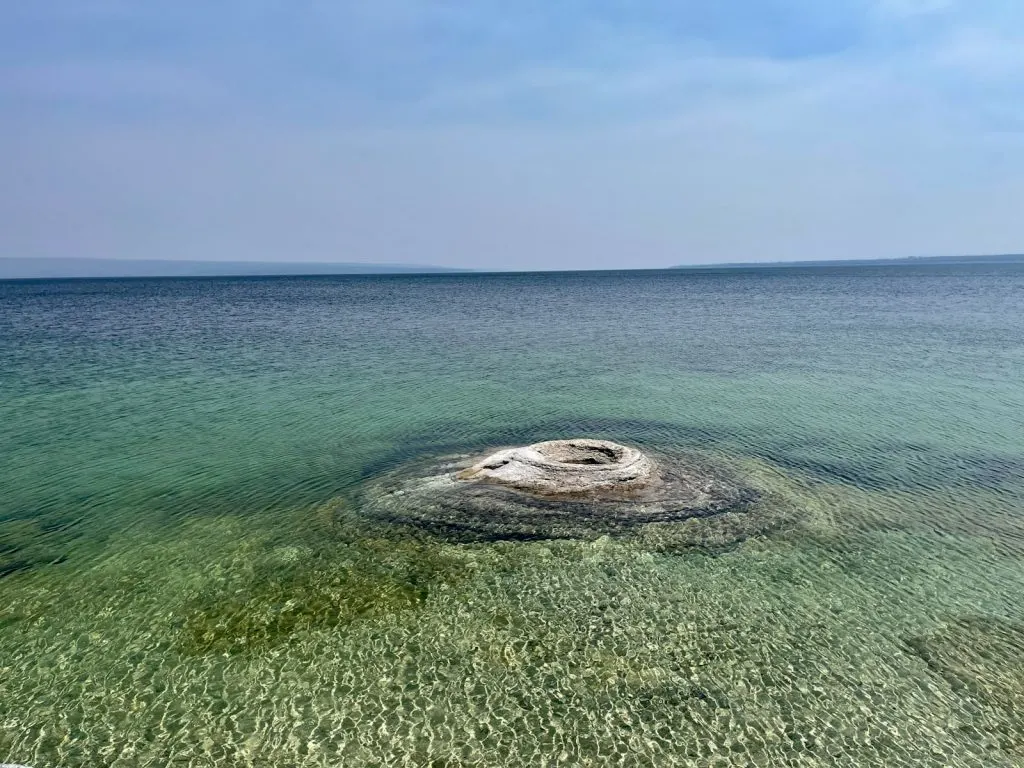
Another popular attraction in the West Thumb Geyser Basin is the Abyss Pool, a gorgeous hot spring named for its depth.
The Abyss Pool is the deepest in the park, over 53 feet deep.
Our favorite in this area was the Black Pool.
The colors and the runoff from this pool were gorgeous.
The boardwalk trail makes this area easy to explore.
Grant Village is nearby if you are getting hungry or need any gas.
Grant Village has a visitor center, food, gas, and lodging.
Grant Village is also a great place to grab a quick snack or picnic supplies for lunch on the road.
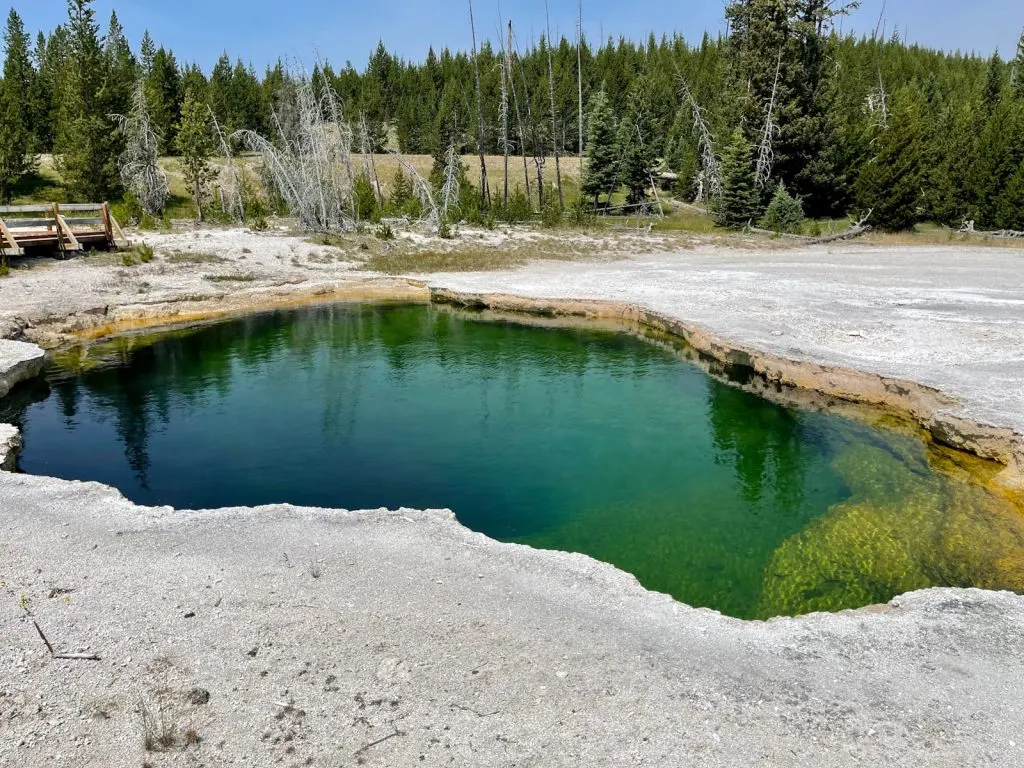

Yellowstone Lake (optional)
While in the area, you might want to explore Yellowstone Lake.
Yellowstone Lake is the largest in Yellowstone, encompassing approximately 132 square miles.
While Yellowstone Lake completely freezes over in the winter, summer allows great fishing and boating opportunities.
Since Yellowstone Lake has an average water temperature of 41 degrees, swimming there any time of the year is not recommended.
So, don’t plan on doing that during your three-day Yellowstone trip.
Yellowstone Lake is a great place to spend time kayaking, boating, or fishing.
Just note that with your 3-day itinerary, this will probably mean that you need to remove a site or two.
Your days in Yellowstone are valuable, so choose wisely!
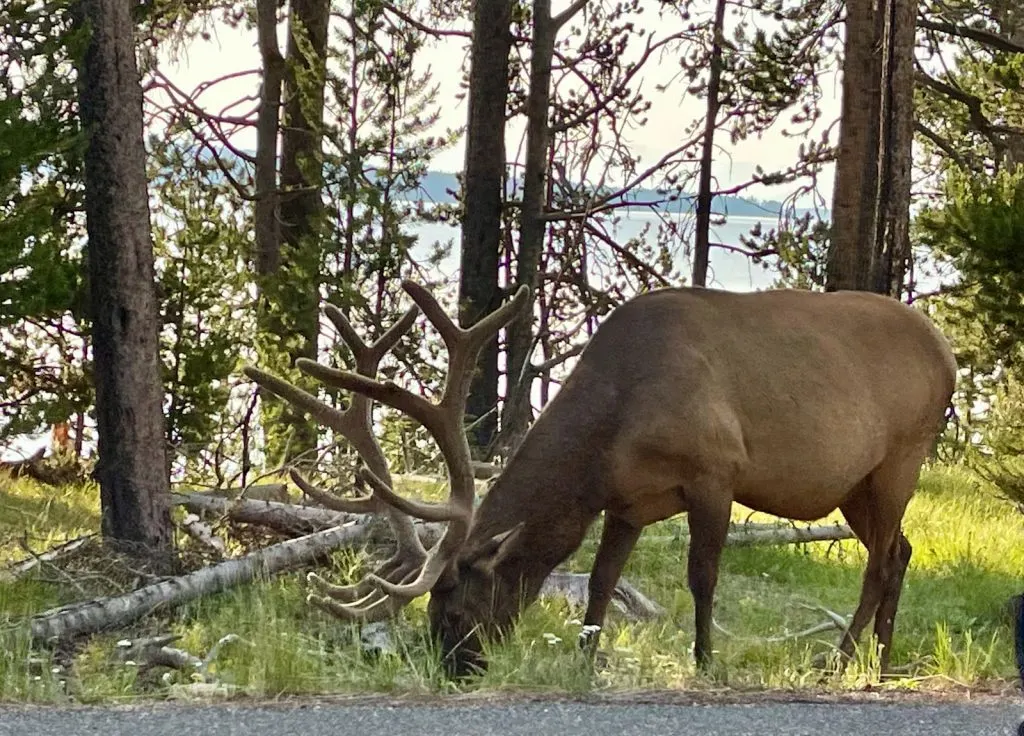
Mud Volcano (optional)
Your drive to the Grand Canyon of Yellowstone will take you past the Mud Volcano and the Dragon’s Mouth Spring.
I wanted to add the Mud Volcano to your itinerary as an optional stop to give you some choices.
The Mud Volcano gets you close to one of the resurgent domes of the volcano, the area of active ground deformation in the park.
This means that this area caused the ground to change (move up or down) with the fluctuation of the magma chamber below.
The landscape is quite interesting, with a black swirl throughout.
This is also where many earthquakes occur, so scientists constantly monitor them.
You will also find the Dragon’s Mouth Spring and the Sulphur Caldron here.
If visiting, be prepared for the pungent smell of sulfur around you!
Grand Canyon of the Yellowstone
Every Yellowstone itinerary includes the Grand Canyon of the Yellowstone.
The Grand Canyon of the Yellowstone is a 24-mile-long canyon that averages around 1,000 feet deep.
This dramatic landscape surrounding the Grand Canyon of Yellowstone includes incredible rock cliffsides, amazing waterfalls, and fabulous vistas to view all of this.
South Rim Drive: Uncle Tom’s Trail and Artist Point
We started our exploration of the Grand Canyon of the Yellowstone on South Rim Drive.
Driving along, take in the gorgeous views of the Grand Canyon of Yellowstone before parking at the Artist Point parking lot.
Follow the walkway down a few stairs and then look to your left.
Here, you are suddenly treated to fantastic views as the canyon opens in front of you and reveals the spectacular lower falls spilling through the canyon walls.
The spray from the falls creates a beautiful foggy haze around the blue river that is in sharp contrast to the creamy-white and brown colors of the canyon.
You immediately understand why this spot is called Artist Point.
Take time to visit all the vista points along the walkway, as each offers a different perspective and equally incredible views.
This part of the Grand Canyon of the Yellowstone was one of my favorite places on our Yellowstone trip and definitely has to be on your Yellowstone itinerary.
There is also a trail called “Uncle Tom’s Trail.” This trail is really about 500 stairs that take you down the side of the canyon and close to the base of the lower falls.
Unfortunately, this trail is closed for safety concerns.
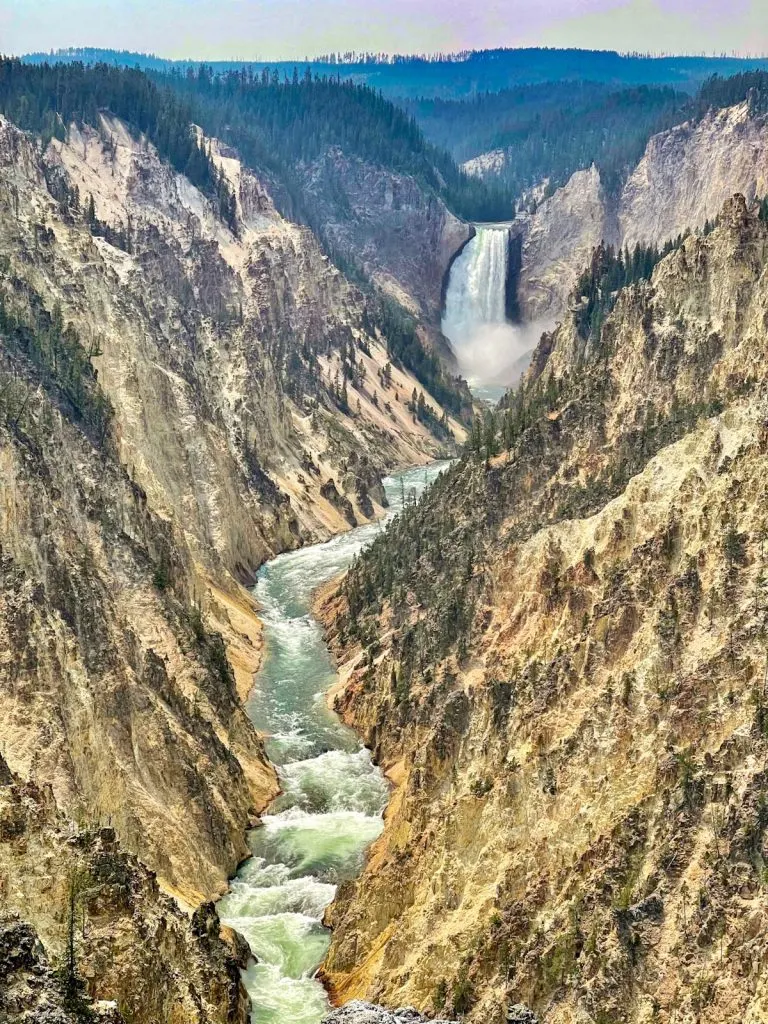

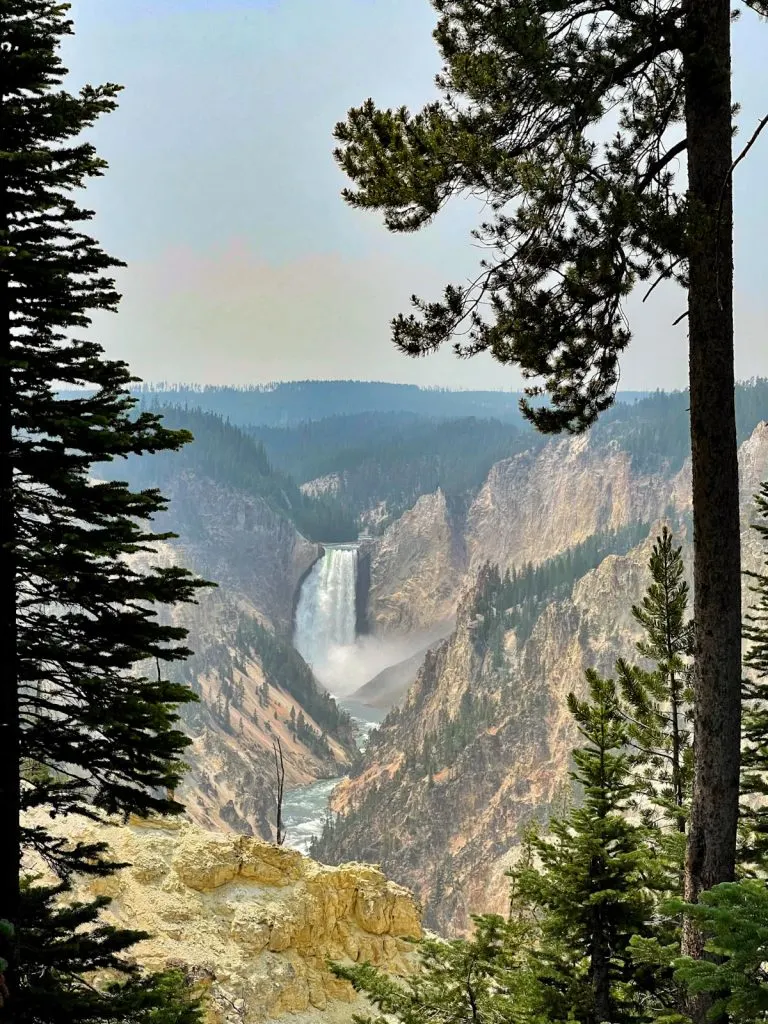
North Rim Drive and the Brink of the Lower Falls
Another fabulous addition to your 3-day itinerary for Yellowstone is to visit the North Rim Drive and the Brink of the Lower Falls along the Grand Canyon of Yellowstone.
North Rim Drive begins 1.2 miles south of Canyon Junction. This one-way street takes you to four different viewpoints of the canyon.
Our favorite stop during this drive, which we feel should definitely be on your Yellowstone itinerary, is the hike down to the edge of the falls.
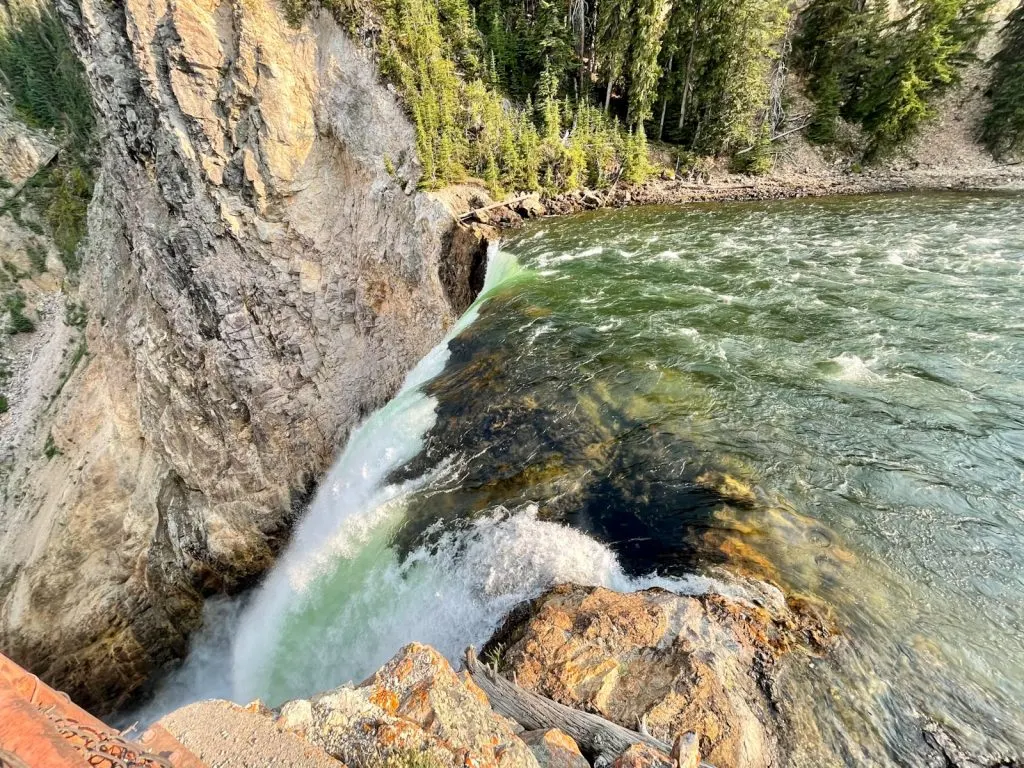
The Lower Falls of the Yellowstone Grand Canyon are the falls you were viewing from Artist Point.
Thanks to this hike, you are about to get up close and personal with the falls.
Follow the trail down the switchback path until you reach the viewing area for the falls.
Here, you see the river spill over the cliffside before continuing through the canyon.
Although the hike back up was not easy for this Texas couple, the time we spent overlooking the falls was well worth it.
After leaving the Brink of the Falls, continue your drive along North Rim Drive. You can stop at Inspiration Point to see another view of the canyon if you would like.
Canyon Village is nearby if you want to grab something for dinner.
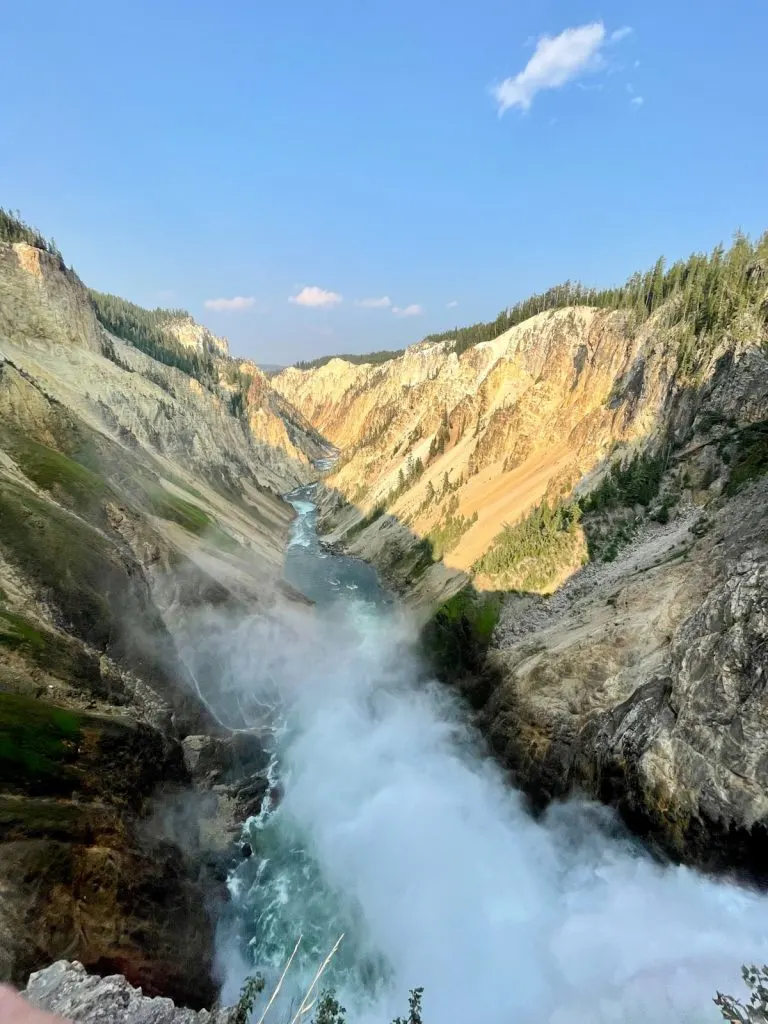
Hayden Valley
Try to time your visit to Hayden Valley Yellowstone to be there just before sunset.
This is the perfect time and place to see some of the amazing wildlife in Yellowstone.
We were excited when we arrived at one of the parking lots in Hayden Valley and saw the elk grazing in the meadow nearby, and then we were even more excited when we spotted the two white wolves in the area.
We sat in this area of Hayden Valley and watched the wolves and elk for over an hour. It was an incredible experience to see them in the wild.
We were told that Hayden Valley is one of the best places to spot wolves, and we were extremely lucky to see them.
We visited Hayden Valley twice during our visit but did not see the wolves again.
Hayden Valley is also a popular place to see bison, so don’t skip adding it to your Yellowstone itinerary!




Day 3: Mammoth Hot Springs
Morning/Midday: Undine Falls, Mammoth Village, and Mammoth Hot Springs
Afternoon: Lamar Valley and/or Boiling River (optional)
Stay in: Mammoth Hot Springs Village
You can go to Lamar Valley twice for today’s itinerary if you don’t mind doubling back on your route.
This would allow you to visit Lamar Valley first thing in the morning (dawn) and again in the evening (dusk) when the animals are most active.
Of course, this is entirely up to you.
Undine Falls
Day 3 of your Yellowstone itinerary will take you to the north loop of Yellowstone.
Today, since you will be staying in Mammoth Hot Springs, you can get a little bit of a later start if you would like.
When ready, start making your way to the park’s north end for our first stop, Undine Falls.
Now, you have a decision to make for your visit to Undine Falls.
You can easily view the falls from the road (which we did), or you can hike the 8.5-mile round-trip hike up Lava Creek Trail to get up close and personal with the falls.
Mammoth Village

Our next stop is Mammoth Village.
Located near the park’s north entrance, Mammoth Village is a great place to spend the final day of your Yellowstone itinerary.
Mammoth Village feels as though you are visiting a small town. This little community in Yellowstone National Park welcomes visitors year-round.
Visit the Albright Visitor Center to learn more about the history of Mammoth Hot Spring and Fort Yellowstone.
The Visitor Center also has a lot of information about the wild animals found throughout Yellowstone.
Mammoth Village also offers restaurants, gas stations, a general store, and hotels. Visit the Terrace Grill for a casual meal like a cheeseburger or sandwich, and don’t forget to grab an ice cream while in the area!
Mammoth Hot Springs
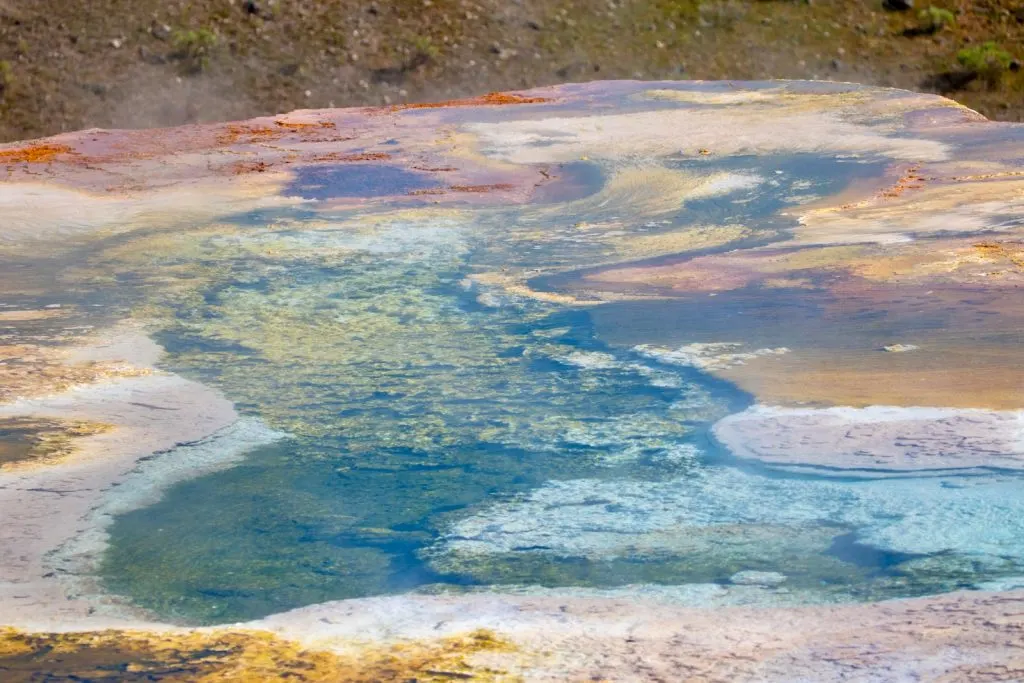
As you know, Yellowstone National Park is above a huge magma chamber. The rainwater seeps into the rocks and rises to the surface once heated.
Instead of being expelled into the air as it is in the Norris Geyser Basin, the water at Mammoth Hot Springs cross the rocks and, in the process, deposit limestone sediment.
The waters flow slowly and deposit the limestone along the way, creating the incredible terraces you see at Mammoth Hot Springs today.
The Mammoth Hot Springs includes 3 terraces, the Upper and Lower Terraces, and the Main Terrace.
Boardwalks connect the terraces so visitors can easily move from one amazing geological feature to the next.




Be sure to view the beautiful Palette Spring, the Terraces of the Main Spring, and Canary Spring (my favorite).
Keep your eyes peeled while in this area, as wildlife is often seen here.
We saw a deer and a lot of elk during our visit to Mammoth Hot Springs.
Mammoth Hot Springs will be a highlight of your Yellowstone itinerary for sure.

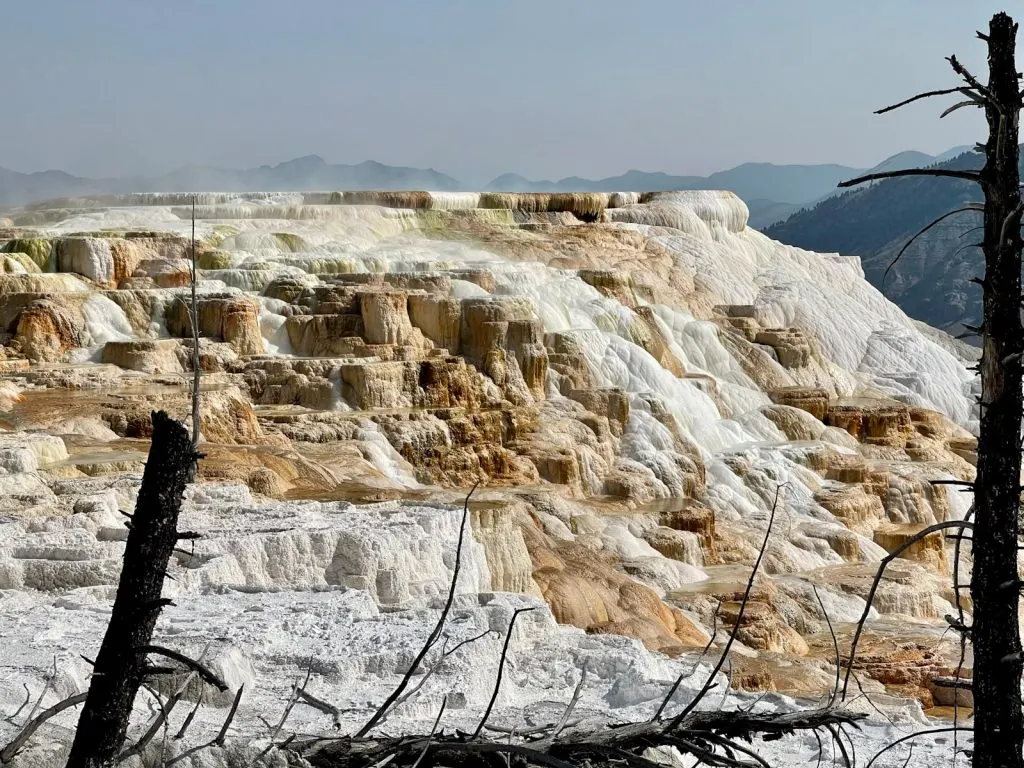

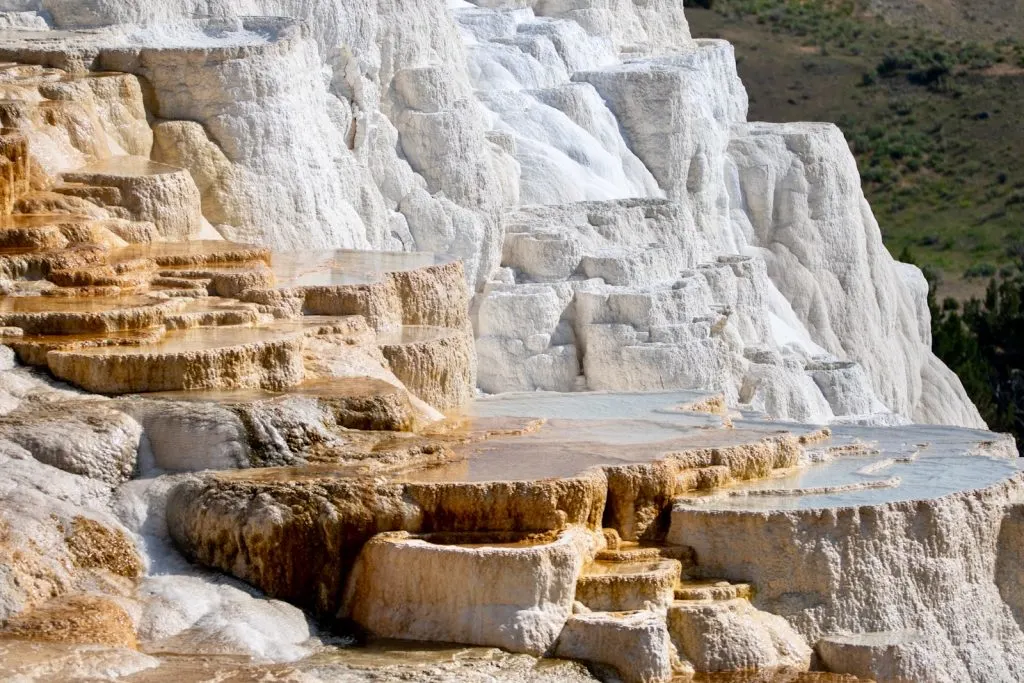
Lamar Valley
If you are like most people, then seeing wildlife during your time in Yellowstone tops your list. Let’s spend this evening in Lamar Valley to see if we can accomplish that.
The road through Lamar Valley Yellowstone is open year-round, making it easy to add this to your Yellowstone list any time of year.
Lamar Valley is located between Tower Junction and the northeast entrance to Yellowstone.
Lamar Valley was created when it was carved out by a glacier over 10,000 years ago, making Lamar Valley the perfect spot to see wildlife in Yellowstone today.
Plan to be at Lamar Valley about 1.5 hours or so before sunset. This is a great time to spot the wildlife.
Lamar Valley is home to many animals, so you definitely want to bring your binoculars on this Yellowstone excursion.
Animals in Lamar Valley include wolves, bison, elk, coyotes, moose, deer, and eagles.
It was in Lamar Valley that I saw a bear during our time in Yellowstone!
We were driving through Lamar Valley Yellowstone when I looked over and saw a huge bear walking toward the tree line.
There were several pullouts along Lamar Valley, so we quickly turned around, but the bear had already disappeared into the tree line.
Whether you see a bear or not, you will likely see wildlife during your time in Lamar Valley.
Boiling River (optional)
With all this water surrounding you, it is hard to resist getting into some of it.
Well, you will be happy to know that there are certain places in Yellowstone where you can get into the water.
One such spot is Boiling River.
Boiling River is open seasonally when the water levels permit.
Note that the park does close Boiling River in spring and early summer as the snowmelt makes the water levels too high to be safe.
Here, the cold water from the Gardner River mixes with the hot water from the Boiling River, creating the perfect soaking area.
Final Thoughts on 3 Day Itinerary for Yellowstone
Yellowstone National Park should be on everyone’s bucket list.
This park has incredible sites you cannot see on this scale in any other area.
While I absolutely loved our time in Yellowstone, I wish we had an extra couple of days to explore Grand Teton as well.
We will have to take another trip back to check Grand Teton off our list.
What would you add to our Yellowstone itinerary? Comment below and let us know.
Like This Post? Please Pin It!



While You’re Here, Check Out These Posts:
Fun Things to do in Hot Springs, Arkansas
10 Reasons to Book a Princess Cruise to Alaska
25 Incredible Things to Do in Savannah, GA
15 Epic Things to Do in New Orleans
70+ Cheap Things to Do in Las Vegas
Glamping in Texas: 15 Fabulous Places to Go
20 Fabulous Small Towns in Texas You Must Visit
Free Things to Do in San Antonio, TX
Romantic Getaways in Texas You Will Love
50 Awesome Texas Bucket List Experiences
36 Fun Things to Do in Colorado Spring
26 Fabulous Things to Do in Eureka Spring
20 Fun Things to do in Estes Park, CO
3 Steamboat Springs Hot Springs You Must Visit

About the Author
Michelle Snell is a travel writer, history buff, wine lover, and enthusiast of different cultures. Michelle enjoys bringing places to life through creative content creation and her informative writing style on her blogs, That Texas Couple and Totally Texas Travel and accompanying social media accounts. She is happiest sipping wine in Italy or chilling on a beach with her husband, Marty.

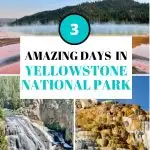
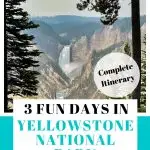
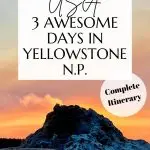
Anja
Sunday 14th of April 2024
This looks great and I would really love to see it on my next US trip. Is it a good idea to visit in winter? Both my "bigger" road trips in the US were in November, with relatively few crowds, and my preferred travel season is November, but Yellowstone is much further north to Arizona, Utah and Nevada where I have been before. WOuld it be foolish to try visit there in November/December?
thattexascouple
Sunday 14th of April 2024
Hi Anja! We have a post on when to visit. If you choose to visit in winter, a lot of the park is closed down because the roads are impassable. Personally, I would recommend fall. This means less crowds but you can still move around the park.
Teja
Sunday 14th of April 2024
Really exhaustive itinerary! It's obvious why Yellowstone gets so many visitors.
thattexascouple
Sunday 14th of April 2024
Yes! It is a fabulous park and is so unique and beautiful!
Jordan
Tuesday 26th of October 2021
I was only able to visit for one day so I will definitely be saving this for when I am able to return for longer. Such a perfect itinerary!
thattexascouple
Friday 29th of October 2021
Thank you so much, Jordan!! Yellowstone really is a magnificent park!
Michelle
Monday 25th of October 2021
I haven’t been to Yellowstone since I was a kid. I would love to go back and explore the amazing places you recommend!
Ashlee Fechino
Sunday 24th of October 2021
This is truly the Ultimate 3 Day Yellow Itinerary! Ya'll captured everything. We can't wait to visit again as adults - I haven't been there since I was a little kid.
thattexascouple
Friday 29th of October 2021
Thank you so much, Ashlee! I definitely recommend returning as an adult. It's a whole different experience.